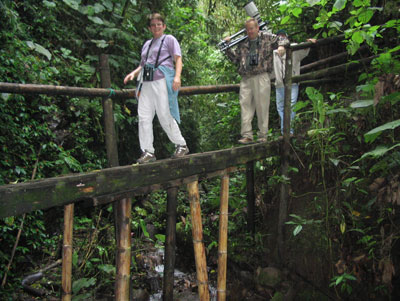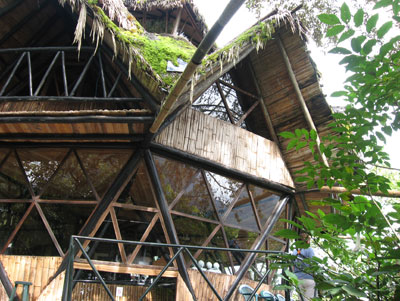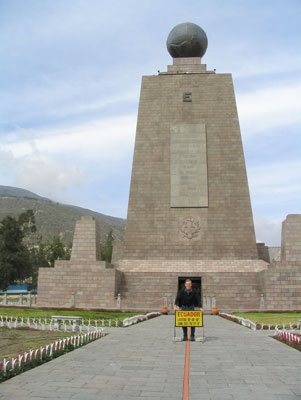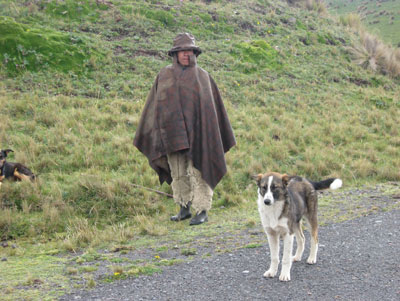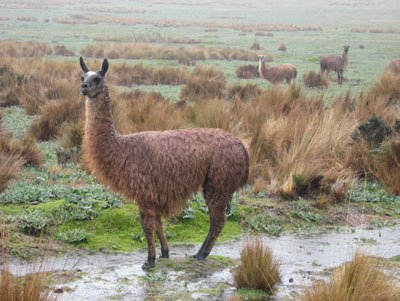Ecuador — Birding below the equator
by Dennis Sherwood, Gig Harbor, WA
Spontaneous applause erupted from the Ecuadorian passengers as we landed, through intermittent fog and rain, at Quito’s international airport. Were they just glad to be home or was it sincere gratitude for our safe passage through the mountains on this dark and cloudy night?
Days later we learned that another flight had overshot the cramped runway during similar weather and damaged the airport’s radar system, so perhaps the ovation was well deserved.
Indeed, why were we going to Ecuador in the first place? Great beaches? Exotic food? Posh hotels? For the birds, actually.
Tiny Ecuador, about the size of Nevada, boasts 1,600 species of birds, with more avian varieties per square mile than anyplace else on the planet. Our home state of Washington has four kinds of hummingbirds; Ecuador boasts 136!
Nate Chappell of Trogon Tours, a fledgling company in more ways than one, and his Ecuadorian wife, Angie, whose Spanish skills proved indispensable on our well-organized wanderings, would lead my wife, Melissa, and me on a 9-day birding adventure. Afterward we planned to spend five days, on a ship and ashore, exploring the nearly mythical Galápagos Islands, a place that the Lonely Planet guidebook suggests “may inspire you to think differently about the world.”
Our arrival
In the Quito airport things seemed a little backward, as our baggage was x-rayed after it was removed from the plane. A prominent sign at Customs warned of stiff penalties for trafficking in children — a hint that we were “not in Kansas” anymore.
Our passports summarily stamped, we were quickly waved through to join six fellow birding enthusiasts and Johnny, our Ecuadorian driver and all-around nice guy.
Our paltry communication skills — “No, gracias” — fended off eager cab drivers as we negotiated our way to the rain-drenched parking lot, winding between packed vehicles to load an impossible mound of luggage into the back of Johnny’s 9-passenger van.
Leaving the parking lot became a game of chicken as drivers intimidated each other with blasts from their horns while wedging ever closer to the exit queue. Nate said, “They have no respect for traffic laws,” and admitted to refusing to drive the challenging streets of Quito. Johnny, a local resident, bluffed with the best of them, much to my wife’s cheering encouragement.
Nearly midnight, we navigated left and right through a confusing maze of streets. As skilled as our Continental pilot, Johnny somehow guided us to a landing at fashionable Akros Hotel, where elegantly dressed doormen offered a friendly welcome — in Spanish, of course.
We were told that breakfast would be at 6:30. “Lots of birds to see tomorrow,” Nate said. Suddenly we were adrift in a foreign land, at the mercy of a possessed birder and his take-no-prisoners itinerary. It was 1 a.m. as we staggered off to our rooms. Welcome to Ecuador!
The adventure begins
Melissa was outside with her binoculars by 6 in the morning scanning the trees around the parking lot next door. Before breakfast she managed to spot a couple of life-list birds, the first of over 200 new species she would eventually spy.
On the road by 9:15, we drove north of the city, stopping briefly at a popular attraction, La Mitad del Mundo (The Middle of the Earth), where an impressive stone monument marks the equator. The English-speaking docent explained to us that when the original site for the monument was surveyed, it crossed a ravine that would not support such a massive structure. This final location, with its bright yellow “equator” line, is a few hundred feet south of the true zero latitude, but go ahead and take a picture anyway.
Back in the van, we turned west, climbing a lofty 2-lane road above the Quito valley to crest the 10,000-foot-high rim of an extinct volcano. We then descended through sharp curves and switchbacks into a landscape of steep green hills lush with vegetation — the renowned cloud forests of Mindo, where Pacific air masses, trapped by the Andes’ front ranges, deposit their abundant moisture.
Extending for 50 miles and dropping from about 12,000 feet down to less than 4,000 feet in elevation, the cloud forests boast a biological diversity of plants and animal life, particularly birds, that is staggering. Only the Amazon Basin is more prolific.
Because some bird species found there are found nowhere else in the world, Mindo has been listed as an Endemic Bird Area (EBA). Worldwide, there are 218 EBAs.
Forest hike
At an elevation of around 7,000 feet we parked at a private reserve, where local guides escorted us on a half-mile hike up a steep, muddy trail. We were looking for an unusual bird, a female Andean cock-of-the-rock, at nest in a rocky alcove near a waterfall.
Forest plants crowded together along the streamside trail, their leaves competing for filtered light. Every horizontal and vertical surface seemed slathered in green.
“Even the leaves have moss,” Melissa observed.
A slippery hike and several stream crossings later we spotted the bird of our search in a dark niche of overhanging rock — russet brown and motionless on her eggs.
Private individuals and organizations are working to protect the Mindo Cloud Forest. Typically, they purchase unspoiled tracts of land and, for a small fee, offer access to ecotourists like us — an Ecuadorian cottage industry. The result is a haphazard patchwork of farms and forest, with the ecology and long-term viability of most species little known.
Beyond the town of Mindo, Johnny turned down a rutted road to Los Colibríes (The Hummingbirds), an outdoor restaurant with a covered porch. We were beginning to realize that nearly everything authentic and worth seeing in Ecuador is at the end of a dirt road.
Feeders hanging from the roofline attracted an amazing rainbow of tiny hummingbirds with equally colorful names — white-bellied woodstar, Andean emerald, green-crowned woodnymph, empress brilliant — perhaps a hundred energetic birds representing 11 species. We ate a delicious lunch amidst their whirl of feeding and territorial frenzy.
Yet another dirt road through the forest jungle took us to what would be our base camp for the next three days, Séptimo Paraíso (Seventh Paradise), a family-run ecolodge and nature reserve that gets my vote for having some of the best meals in all of Ecuador.
Broccoli soup, salad, baked chicken and nut cake with fruit sauce rounded out the dinner menu. Each meal included a selection of fresh fruit juices such as coconut, passion fruit, guanábana, tamarindo, naranjilla, tomate de árbol (tree tomato, which resembles a tomato but tastes rather like peach) and a delicious purple-red berry called mora, each of them incredibly thick, rich and flavorful.
A magical day
The evil itinerary compelled us to an early breakfast at 4 a.m., two hours before sunrise. Nate said we needed to arrive at Refugio Paz de las Aves before dawn to see male cock-of-the-rocks — brilliant red, black and white birds — at a lek. Leks are places where groups of male birds gather, typically around sunrise, to attract breeding females with extravagant displays of colorful feathers and distinctive calls. We’d heard others say this was their most amazing bird encounter in Mindo, perhaps in all of Ecuador.
By 5:15 a.m. we arrived at a clearing high on a ridge above the forest, bright stars shining overhead. Conspicuously missing was the North Star, lost below the northern horizon at this latitude. Flashlights in hand, we quietly followed Angel Paz, a certified native guide, down a steep canyon trail into the jungle darkness. Wooden planks on the muddy path and secure hand ropes tied between trees helped steady our steps.
Angel’s family purchased this land 20 years ago intending to clear it for agriculture, cattle and crops, but when the lek was discovered as well as another unusual bird, the antpitta — seldom heard and rarely seen — the family decided instead to protect the forest. This unique experience for birders has become so popular that reservations are essential.
Half a mile down the trail, just upslope from the lek, we crowded into a frond-covered blind. Within minutes, two, then three male cock-of-the-rocks suddenly appeared, elegant foot-tall birds with blood-red heads, flitting between branches while squawking loudly like the squealing of a pig. Their improbable display was stunning, especially as we considered how this startling event has taken place for tens of thousands of years.
Sunlight slowly penetrated the forest as Angel led us farther into the gorge’s vertical landscape of tree ferns, bromeliads and rubber trees — a kingdom of plants that obscured all but a narrow blue arc of sky. The footpath ended at a noisy stream that spilled from a jungle opening before quickly disappearing again into the dense growth.
Halfway back up the trail, we waited while Angel offered worms from a can as he called out, “Maria, venga!” (“Come!”) Soon, a crow-size, rust-colored antpitta, shy and seldom seen, emerged from the undergrowth and cautiously hopped on a stump to gobble his offering. We were held speechless as Angel gently stroked her feathers, turning toward us to whisper, “Magia” (“Magic”).
Jungle jaunt
Early again the next morning we drove farther west to Silanche forest reserve at less than 2,000 feet, the lowest elevation we visited on the Ecuador mainland. The warm, humid air had a definite jungle feel about it — as well as the potential for dengue fever and malarial mosquitoes. Yikes!
We climbed a 40-foot viewing tower at treetop level to set up scopes and cameras. Green screeching parrots whizzed past and black-and-yellow toucans hopped between tree limbs, plucking fruits with their oversized bills.
Back on the ground, we followed a path through maybe a thousand kinds of plants tangled together with chirps and clicks of insects, strange birdcalls and an acrobatic squirrel. Long vines dangled from limbs in the canopy overhead. Any moment we expected Tarzan to come swinging in.
Giant, 3-inch-long millipedes moved along unhurried, but there were no centipedes, whose bites are said to be painfully venomous. Along one section of trail, thousands of tiny angular leaf fragments lay scattered in a line, no doubt the toil of leaf-cutter ants. But where were the workers? It was as if they’d suddenly dropped their loads at quitting time and gone for lunch.
The search continues
Yet another early morning (remember, this was not a vacation) found us near town at a busy intersection that may have had the only streetlamp in Mindo. Unusual birds, such as the multicolored toucan barbet, arrived there at dawn to feed on moths attracted by the light. Plucked moth wings littered the road like discarded potato chips from a tailgate party. We joined a dozen birders dodging-early morning traffic that seemed accustomed to this local craze.
After lunch again at Séptimo Paraíso, we were off to Bellavista Cloud Forest Reserve, a popular ecolodge perched on a narrow ridge above the forest at 7,400 feet. Its unique octagonal building with a 360-degree view is called, for good reason, the Tree House. Guides offer scheduled walks to the best birding sights on trails that radiate from the lodge. The owners have purchased over 1,700 surrounding acres — another example of generous private stewardship.
Early the next morning we joined a walk before breakfast with Gabby, one of Bellavista’s resident guides. Raucous birds called out, including the curious and sociable turquoise jay, stunning in his light- and dark-blue tuxedo.
Reluctantly, we left Bellavista and returned toward Quito, quickly passing through the forest hamlet of Tandayapa, about three sneezes in length. Residents actually waved at us, unaccustomed as they were to tourists. A tiny store, like so many in Ecuador, displayed super-sized plastic bottles of red, orange and green sodas. With questionable water quality everywhere, it must be the national drink.
Evening found us back at the Akros Hotel, our base for the next three days.
By 7 a.m. we were driving to Pichincha, a nearby 15,000-foot semiactive volcano that last erupted in 1999, blanketing the city in ash. We walked what’s called the “Inca Trail” along the volcano’s flank while searching for birds.
Back in Quito, Nate suggested we go to dinner at a barbecue restaurant near the center of town. Getting there was an adventure. We were told that Quito’s already-crowded streets accumulate an additional 50,000 vehicles each year. Pedestrians have no right-of-way, and traffic lanes are merely advisory.
Johnny asked the restaurant’s security guard to watch our camera-laden vehicle while went in to order every meat on the menu — pork, chicken, beef and blood sausage — grilled over a long bed of glowing coals and brought to our table on a rack of hot coals to keep it warm. It was ingenious, but I don’t think it would pass any fire code in the States.
Winding down
On our last day with Nate we drove southeast into the Andes above 12,000 feet, a habitat known as the páramo which extends from southern Costa Rica to northern Peru. To prevent poaching, written permission is required to enter this private reserve, paperwork that’s checked at each of three successive guard stations. Even so, Johnny had to relinquish his driver’s license at the last gate to ensure we returned by 5 p.m.
In the high páramo, forest finally yields to rocky ridgelines and grassy plains, suitable rangeland for cattle, sheep and domesticated llamas.
In the morning we expressed our gratitude and good-byes to Nate and Angie and joined some of the members of our group in a taxi to the airport. We were flying to the Galápagos Islands, 600 miles off the coast of Ecuador.
The cost of our 9-day December ’07 Ecuador tour with Trogon Tours (Lakewood, WA; 253/512-1060, www.trogontours.net) was $1,800 per person, including accommodations, meals and in-country transportation. Trogon's 2009 tour to Ecuador, which is a bit longer at 12 days, costs $3,100 per person.
Next month, the journey continues in the Galápagos Islands.


